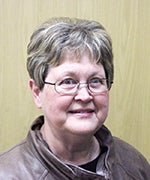Carol Hegel Lang: There is always something happening every day in the gardens
Published 9:00 am Sunday, May 29, 2016
Serendity Gardens by Carol Hegel Lang
Carol Hegel Lang is a green thumb residing in Albert Lea. Her column appears weekly. Email her at carolhegellang@gmail.com.
Every day there is so much happening when I am in the gardens. Some of it gets caught on my camera, while other times it will only be a memory in my mind.
This morning I was out on doggy doo patrol to get the yard cleaned up before my husband mows. I was returning to the garage when a blue blur on the elevated bird feeder caught my eye. At first glance I thought it was an indigo bunting, but it was not the same color. When he turned toward me, the rusty chest screamed bluebird! This is the first time I have had one visit my gardens. I didn’t have any mealworms out for him, so I am not certain he will stick around.
You have to know how passionate I am about wildlife in the gardens to understand that I dropped what I was doing. I ran into the house to grab my camera and phone so that I could call my husband’s cousin, Neil (didn’t think you would get your name in my column again did ya?) to give him my Lincoln Avenue bird sighting report so that I could one-up him.
The next phone call was to my younger brother, who lives on an acreage, and I think he was as excited as I was. He is always telling me to put up bluebird houses and I will get them, so I guess you know that I will now. Oh, how I love sharing wildlife activity with these two guys.
On my rounds I noticed three of my hosta look like the frost had nipped them pretty good. I guess I will watch and see how they look. In time I may have to cut them to the ground and see if they come back. The tiger eye sumac was also nipped on the ends of the leaves that were budding out. One of the millet bit the dust and all of the coleus that were covered don’t look very good. It has not been a great week for garden plants. Thank goodness I have been too busy giving monarch speeches to get any of my annual seeds planted. I now don’t have to worry about replanting them.
In the front entry garden, the tiarella are in full bloom along with alliums just opening and the Miss Kim lilac. The wrens were serenading each other and I saw one of them on the birdhouse in the center of this garden. The birds may possibly make a home in it again. This is not a real birdhouse and there is no opening for me to clean it out. However, I have had wrens nest in it before.
The tumbling Tom tomato plants along with the gypsy pepper plants are still finding a home in the greenhouse, as it has been too cool to plant them outside. In the strawberry container — where I have herbs planted — the tops of the pineapple sage were nipped by the cold temperatures. I nipped a couple of inches off of them and will see what becomes of them.
I am waiting for my strawberry plants to arrive. I couldn’t find them locally, so I had to order them from one of the seed catalogs. They are the ever-bearing Toscana variety and I had them last year on the patio table in the Victorian garden. Every morning I picked enough to have with my breakfast and they were so sweet and delicious.
The orange butterfly milkweed is coming up in the cutting garden, but there is still no sign of the common milkweed. Last year the common milkweed was afflicted with oleander aphids that just covered them late in the season. When I researched the aphids online, it said there was a 50/50 chance they wouldn’t survive if the infestation was massive and mine was. At least I have plenty of butterfly milkweed planted. The meadow blazing star that I planted are growing well and I can’t wait to see how they will attract monarch butterflies this summer.
In the small wildflower garden, my trilliums have been blooming, adding a tiny patch of color to the area. Virginia bluebells are about done blooming and will disappear late in June once they dry out. I won’t see them again until next spring, but they are so worth having in your shade gardens. When they bloom they are gorgeous!
“There is nothing in which the birds differ more than the way in which they can build and yet leave a landscape as it was before.” — Robert Lynd



